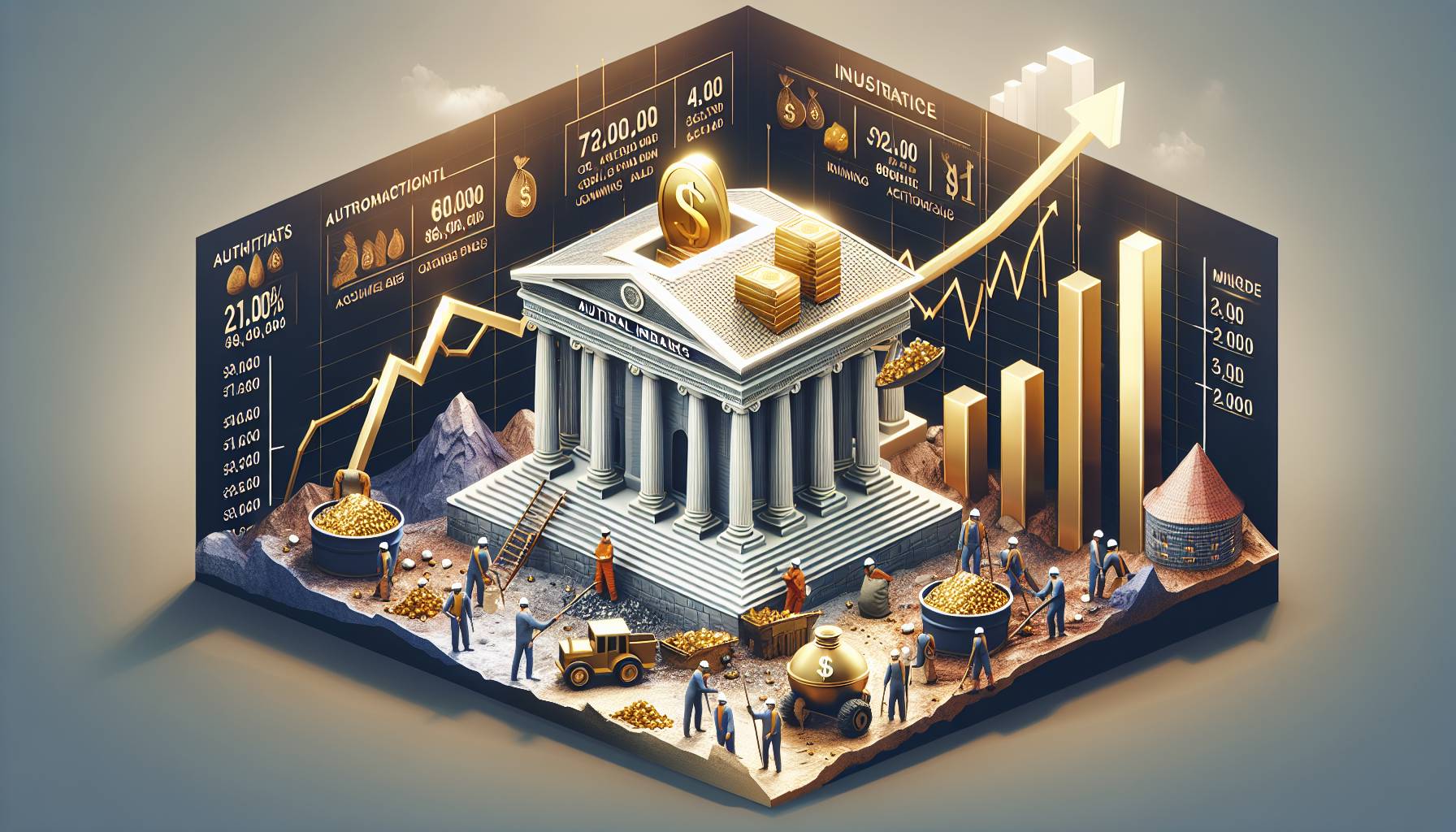Economic indicators affecting gold prices
Several economic indicators play a crucial role in influencing gold prices. One of the primary factors is inflation rates. When inflation is high, the purchasing power of currency declines, leading investors to seek refuge in gold, which is often seen as a hedge against inflation. This increased demand can drive up gold prices.
Interest rates also significantly impact gold prices. Generally, when interest rates are low, the opportunity cost of holding non-yielding assets like gold decreases, making gold more attractive to investors. Conversely, higher interest rates can lead to a stronger currency and reduced demand for gold, potentially causing prices to fall.
Currency fluctuations, particularly in the US dollar, are another important economic indicator. Since gold is typically priced in US dollars, a weaker dollar makes gold cheaper for foreign investors, boosting demand and prices. On the other hand, a stronger dollar can make gold more expensive for overseas buyers, potentially dampening demand.
Additionally, economic growth indicators such as GDP growth rates can influence gold prices. In times of economic uncertainty or slow growth, investors may turn to gold as a safe haven, driving up prices. Conversely, strong economic growth can lead to increased confidence in other investment vehicles, potentially reducing the demand for gold.
Lastly, government policies, including fiscal and monetary policies, can also affect gold prices. For instance, expansive monetary policies that increase money supply can lead to inflationary pressures, prompting investors to buy gold as a protective measure.
Geopolitical events and their impact
Geopolitical events can have a profound impact on gold prices, often causing significant fluctuations. Political instability or conflict in key regions can lead to uncertainty in global markets, prompting investors to seek safe-haven assets like gold. For instance, tensions in the Middle East or escalating conflicts in Eastern Europe can drive up demand for gold as investors look to protect their portfolios from potential market volatility.
Trade disputes and international sanctions are other geopolitical factors that can influence gold prices. When major economies engage in trade wars or impose sanctions, it can disrupt global trade flows and economic stability, leading to increased demand for gold. Investors may perceive gold as a more stable investment during such turbulent times, pushing prices higher.
Changes in government leadership or policy shifts in major economies can also affect gold prices. Elections, especially in countries with significant influence on the global economy, can create uncertainty about future economic policies. This uncertainty can lead to increased gold purchases as investors hedge against potential policy changes that could impact economic growth or currency stability.
Furthermore, geopolitical alliances and treaties can play a role in shaping gold prices. For example, agreements that promote economic cooperation and stability can reduce the perceived need for safe-haven investments, potentially leading to a decrease in gold demand. Conversely, the dissolution of such alliances or the emergence of new geopolitical tensions can increase demand for gold.
Geopolitical events are a critical factor in the dynamics of gold pricing, as they can swiftly alter investor sentiment and market conditions, leading to rapid changes in demand and price levels.
Market sentiment and investor behavior
Market sentiment and investor behavior are pivotal in determining the trajectory of gold prices. The perception of gold as a safe-haven asset often drives investor behavior, especially during periods of economic uncertainty or market volatility. When investors anticipate potential downturns in the stock market or other financial sectors, they may increase their gold holdings, leading to a rise in prices.
Investor behavior is also influenced by trends and narratives within the financial community. For instance, if influential market analysts or financial institutions project a bullish outlook on gold, it can lead to increased buying activity among investors, further driving up prices. Conversely, a bearish sentiment can result in selling pressure, causing prices to decline.
Speculative trading plays a significant role in shaping market sentiment. Traders who engage in short-term buying and selling based on price movements can contribute to volatility in gold prices. This speculative activity is often driven by technical analysis and market trends rather than fundamental economic indicators.
Additionally, the behavior of institutional investors, such as hedge funds and mutual funds, can have a substantial impact on gold prices. These large entities can move significant amounts of capital into or out of gold markets, influencing overall demand and price levels. Their investment strategies are often based on a combination of market analysis, risk assessment, and portfolio diversification goals.
The psychological factors that influence individual investors cannot be overlooked. Fear and greed are powerful motivators in financial markets, and gold is no exception. During times of fear, such as economic recessions or geopolitical tensions, investors may flock to gold as a perceived safe asset. On the other hand, during periods of economic optimism, investors might shift their focus to higher-yielding assets, reducing demand for gold.
Factors influencing gold price trends
Gold prices are influenced by a myriad of factors, each playing a crucial role in determining the market’s direction. One of the primary drivers is global economic stability. In times of economic uncertainty, investors often flock to gold as a safe haven, pushing prices upward. Conversely, when economies are stable and growing, the demand for gold may decrease, leading to a potential dip in prices.
Inflation rates also significantly impact gold prices. As inflation rises, the purchasing power of currency diminishes, making gold an attractive investment to preserve wealth. This relationship often results in increased demand and higher prices. Additionally, interest rates are closely watched by investors. Lower interest rates reduce the opportunity cost of holding non-yielding assets like gold, thereby boosting its appeal.
The strength of the US dollar is another critical factor. Gold is typically priced in US dollars, so a weaker dollar makes gold cheaper for foreign investors, increasing demand and driving up prices. Conversely, a strong dollar can have the opposite effect.
Geopolitical tensions and market volatility can also lead to fluctuations in gold prices. During periods of political unrest or market instability, investors often seek the security of gold, which can lead to price surges. Lastly, supply and demand dynamics play a fundamental role. Limited supply from mining operations or increased demand from sectors like jewelry and technology can significantly influence prices.
Potential scenarios for future gold prices
As we look ahead, several potential scenarios could unfold for gold prices, each influenced by the interplay of economic, geopolitical, and market factors. One possibility is a continued upward trend in gold prices, driven by persistent economic uncertainties and inflationary pressures. In this scenario, investors may increasingly turn to gold as a hedge against inflation and currency devaluation, sustaining high demand and elevated prices.
Alternatively, if global economies stabilize and interest rates rise, we might witness a pause or even a decline in gold prices. Higher interest rates could make other investments more attractive compared to non-yielding assets like gold, potentially reducing its appeal. Additionally, a strengthening US dollar could exert downward pressure on gold prices by making it more expensive for foreign buyers.
Geopolitical developments also present a wildcard in forecasting gold’s future. Escalating tensions or conflicts could spur a flight to safety, boosting gold demand and prices. Conversely, diplomatic resolutions and improved global relations might ease investor concerns, leading to a moderation in gold’s allure.
Finally, technological advancements and shifts in consumer preferences could impact gold’s supply and demand dynamics. Innovations in mining technology might increase supply, while changes in consumer behavior, such as a growing preference for sustainable and ethical sourcing, could influence demand patterns.
Investors should remain vigilant, monitoring these evolving factors to make informed decisions about their gold investments. The future of gold prices is inherently uncertain, but understanding these potential scenarios can provide valuable insights for navigating the market.

